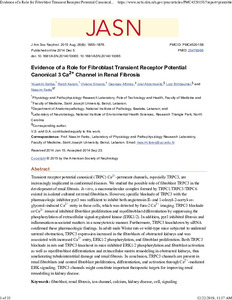Please use this identifier to cite or link to this item:
https://repositorio.uca.edu.ar/handle/123456789/9419| Título: | Evidence of a role for fibroblast transient receptor potential canonical 3 Ca2+ channel in renal fibrosis | Autor: | Saliba, Youakim Karam, Ralph Smayra, Viviane Aftimos, Georges Abramowitz, Joel Birnbaumer, Lutz Farès, Nassim |
Palabras clave: | ENFERMEDADES RENALES; ENFERMEDADES CARDIOVASCULARES; FIBROSIS; CALCIO; CANALES IONICOS | Fecha de publicación: | 2015 | Cita: | Saliba, Y., Karam, R., Smayra, V., et al. Evidence of a role for fibroblast transient receptor potential canonical 3 Ca2+ channel in renal fibrosis [en línea]. Journal of the American Society of Nephrology. 2015, 26(8). Disponible en: https://repositorio.uca.edu.ar/handle/123456789/9419 | Resumen: | Abstract: Transient receptor potential canonical (TRPC) Ca -permeant channels, especially TRPC3, are increasingly implicated in cardiorenal diseases. We studied the possible role of fibroblast TRPC3 in the development of renal fibrosis. In vitro, a macromolecular complex formed by TRPC1/TRPC3/TRPC6 existed in isolated cultured rat renal fibroblasts. However, specific blockade of TRPC3 with the pharmacologic inhibitor pyr3 was sufficient to inhibit both angiotensin II- and 1-oleoyl-2-acetyl-snglycerol– induced Ca entry in these cells, which was detected by fura-2 Ca imaging. TRPC3 blockade or Ca removal inhibited fibroblast proliferation and myofibroblast differentiation by suppressing the phosphorylation of extracellular signal-regulated kinase (ERK1/2). In addition, pyr3 inhibited fibrosis and inflammation-associated markers in a noncytotoxic manner. Furthermore, TRPC3 knockdown by siRNA confirmed these pharmacologic findings. In adult male Wistar rats or wild-type mice subjected to unilateral ureteral obstruction, TRPC3 expression increased in the fibroblasts of obstructed kidneys and was associated with increased Ca entry, ERK1/2 phosphorylation, and fibroblast proliferation. Both TRPC3 blockade in rats and TRPC3 knockout in mice inhibited ERK1/2 phosphorylation and fibroblast activation as well as myofibroblast differentiation and extracellular matrix remodeling in obstructed kidneys, thus ameliorating tubulointerstitial damage and renal fibrosis. In conclusion, TRPC3 channels are present in renal fibroblasts and control fibroblast proliferation, differentiation, and activation through Ca -mediated ERK signaling. TRPC3 channels might constitute important therapeutic targets for improving renal remodeling in kidney disease. | URI: | https://repositorio.uca.edu.ar/handle/123456789/9419 | ISSN: | 1046-6673 (impreso) 1533-3450 (en línea) |
Disciplina: | MEDICINA | DOI: | 10.1681/ASN.2014010065 | Derechos: | Acceso Abierto | Fuente: | American Society of Nephrology. 2015, 26(8) |
| Appears in Collections: | Artículos |
Files in This Item:
| File | Description | Size | Format | |
|---|---|---|---|---|
| evidence-role-fibroblast-transient.pdf | 1,35 MB | Adobe PDF |  View/Open |
Page view(s)
364
checked on Dec 8, 2025
Download(s)
247
checked on Dec 8, 2025
Google ScholarTM
Check
Altmetric
Altmetric
This item is licensed under a Creative Commons License

